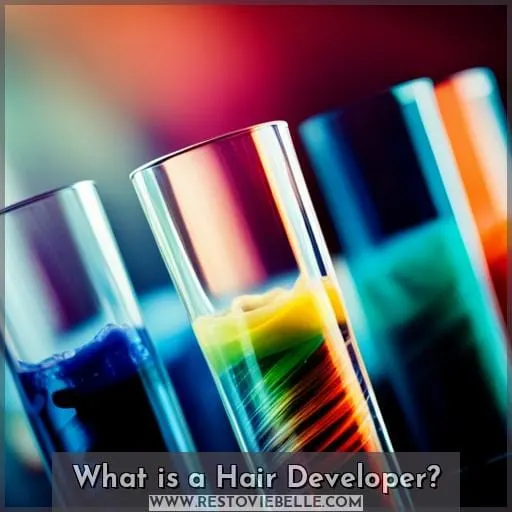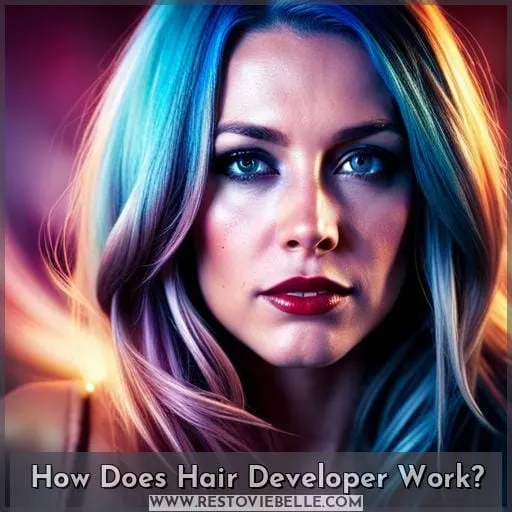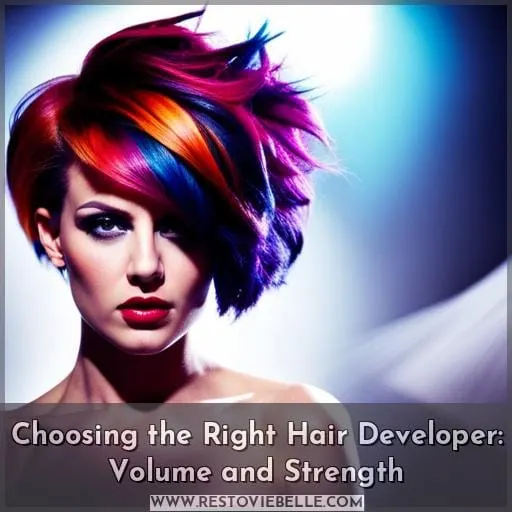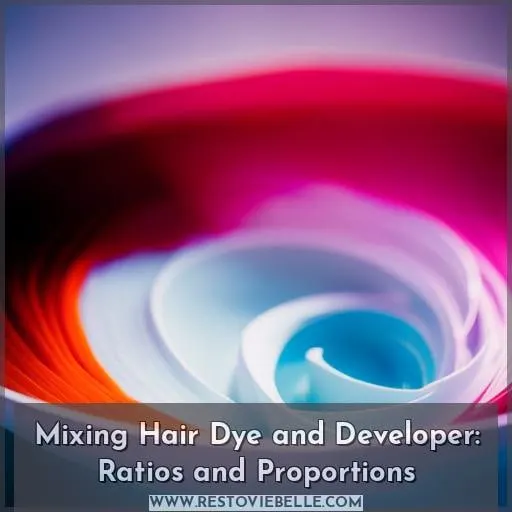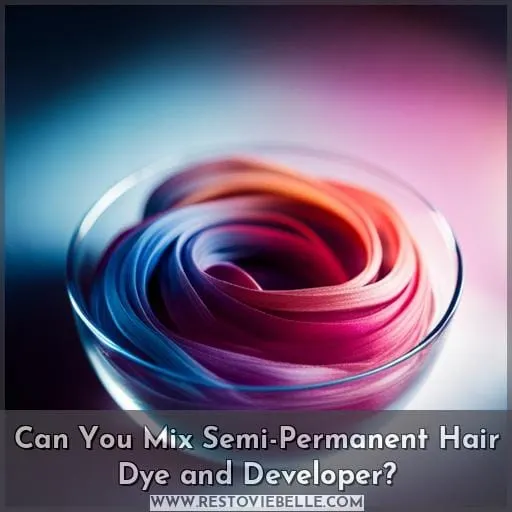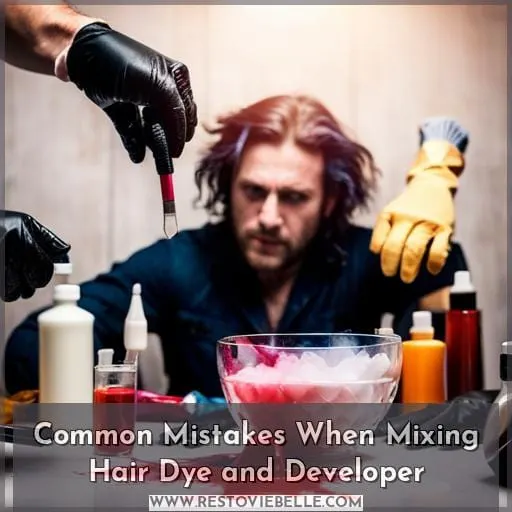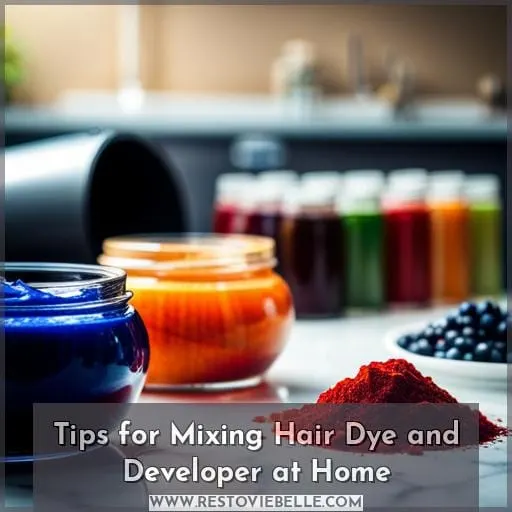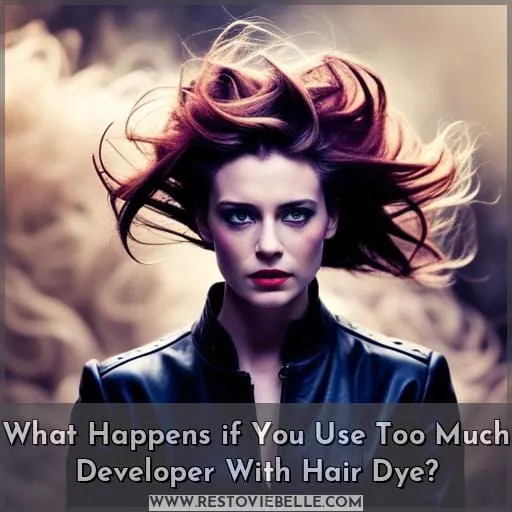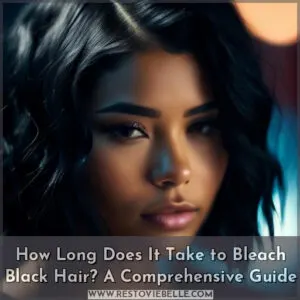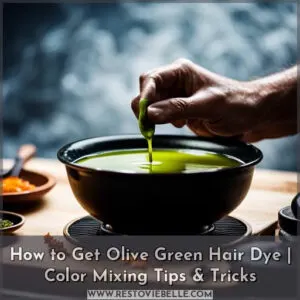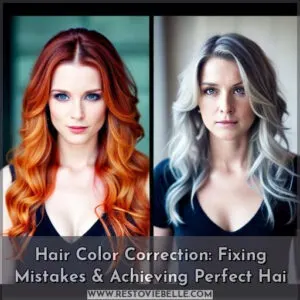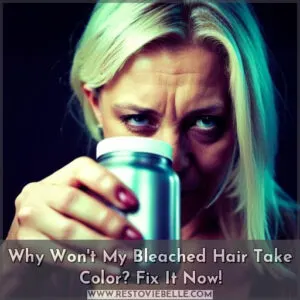This site is supported by our readers. We may earn a commission, at no cost to you, if you purchase through links.
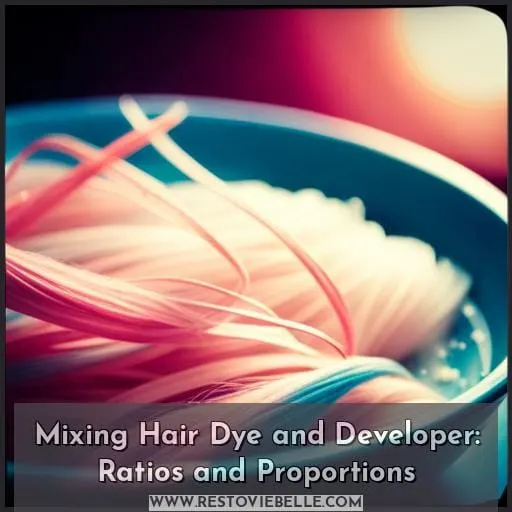 Ready to take your hair game to the next level? Well, get ready because we’re about to dive into the world of mixing hair dye and developer.
Ready to take your hair game to the next level? Well, get ready because we’re about to dive into the world of mixing hair dye and developer.
Wondering if you can mix them together? The answer is yes! But before you start experimenting like a mad scientist, it’s important to understand the ratios and proportions for optimal results.
In this article, we’ll guide you through everything you need to know about mixing hair dye and developer so that you can achieve salon-worthy color at home.
Let’s get started!
Table Of Contents
- Key Takeaways
- What is a Hair Developer?
- How Does Hair Developer Work?
- Choosing the Right Hair Developer: Volume and Strength
- Mixing Hair Dye and Developer: Ratios and Proportions
- Can You Mix Different Brands of Hair Dye and Developer?
- Can You Mix Semi-Permanent Hair Dye and Developer?
- Common Mistakes When Mixing Hair Dye and Developer
- Tips for Mixing Hair Dye and Developer at Home
- What Happens if You Use Too Much Developer With Hair Dye?
- Frequently Asked Questions (FAQs)
- Conclusion
Key Takeaways
- Hair developer, also known as activator or peroxide, contains hydrogen peroxide.
- Developer strength determines lifting power for color changes.
- Follow specified mixing ratios and perform a strand test before full application.
- It’s possible to mix different brands, but color compatibility is crucial.
What is a Hair Developer?
What exactly is a hair developer?
Hair developer, also known as activator or peroxide, is an essential component in the process of coloring hair. It contains hydrogen peroxide, which helps to open the cuticle layer of the hair and activates color molecules for effective penetration.
The strength of a developer refers to its volume or concentration of hydrogen peroxide.
Higher volume developers provide more lifting power and are suitable for drastic color changes, while lower volume developers are used for subtle shifts in shade or gray coverage.
Choosing the right developer strength depends on your desired outcome and natural hair color. Mixing ratios between dye and developer vary depending on brand instructions but generally follow a 1:1 ratio for optimal results without over-processing the hair.
How Does Hair Developer Work?
Hair developer works by oxidizing the hair dye, allowing it to penetrate the hair cuticle and create a lasting color. This process is essential for achieving vibrant and long-lasting results when coloring your hair.
- Oxidizing Process: The hydrogen peroxide in the developer acts as an oxidizer, breaking down natural melanin in the hair shaft.
- Color Penetration: As the cuticle opens up due to oxidation, the dye molecules can easily enter and bond with your natural or previously colored pigment.
By understanding how a Hair Developer Functions through its oxidizing process that allows better penetration for longer-lasting colors while providing safe usage options with different strengths; you have gained mastery over preventing disasters during mixing processes.
Choosing the Right Hair Developer: Volume and Strength
When it comes to choosing the right hair developer, there are a few key factors to consider.
The volume and strength of the developer will play a significant role in achieving your desired color outcome.
Higher-volume developers provide more lifting power for drastic changes, while lower volumes are ideal for subtle shifts or gray coverage.
It’s important to follow manufacturer’s instructions and experiment with different volumes to find what works best for your specific goals.
Mixing ratios for optimal results
To achieve optimal results when mixing hair dye and developer, it’s important to consider the correct ratios and proportions of the two components.
Strand testing can help determine the right developer strength for your hair type.
Mixing techniques play a crucial role in ensuring even color distribution and avoiding color variation.
Individual characteristics, such as natural hair color, can also impact the final result.
By understanding these factors, you can activate color molecules effectively and achieve beautiful hair color outcomes.
Understanding hair developer
When choosing the right hair developer for your needs, it’s important to understand the volume and strength that will yield optimal results.
The developer acts as an oxidizing agent, opening the cuticle for dye penetration.
Strength is measured in volumes from 10 to 40. Higher volumes provide more lifting power for dramatic color changes, but exercise caution against excessive use which can damage hair.
Choosing the right develope
Now let’s delve into choosing the right hair developer to achieve your desired results.
Select developer strength or volume based on the extent of color change sought – subtle shifts warrant lower volumes while dramatic transformations require higher developer volumes around 30 or 40.
Follow manufacturer guidelines for ideal mixing ratios, but also experiment with adjustments to determine what yields optimal color payoff for your hair goals.
Adhering to around a 1:2 hair dye to 20 volume developer ratio is a safe starting point before customizing.
Mixing Hair Dye and Developer: Ratios and Proportions
Now let’s delve into the important aspect of mixing hair dye and developer: understanding the ratios and proportions that ensure optimal results.
- Follow the mixing ratio specified on the boxes (typically 1:1 or 1:2 dye to developer).
- When mixing brands, choose products with similar developer strengths for better blendability.
- Perform a strand test, applying the mixture to a small section of hair before full application. Check for desired color development and absence of irritation. This prevents potential color disasters.
Can You Mix Different Brands of Hair Dye and Developer?
If you’re wondering whether it’s possible to mix different brands of hair dye and developer, the answer is yes. However, pay close attention to Color Compatibility between the brands and any potential Brand Interactions.
Developer Variations like 10, 20, 30, or 40 volumes may also impact Cross-Brand Results.
While mixing different professional hair colors can provide more nuanced options, it does introduce Mixing Challenges around achieving your ideal shade. Consult the hair color numbering system for guidance, but be prepared for some trial and error.
With care and patience, creative mixing between hair dyes and developers can expand your at-home coloring possibilities. But proceed with realistic expectations, as Cross-Brand Results will likely differ from single-brand use.
Can You Mix Semi-Permanent Hair Dye and Developer?
When mixing hair dye and developer, it’s important to consider whether you can mix semi-permanent hair dye and developer.
- Compatibility Concerns. Verify the semi-permanent dye allows mixing to avoid poor results.
- Developer-Free Options. Many semi-permanent dyes don’t require developer for application.
- Alternative Application Methods. Try heat, wrap, or cap methods for better color penetration.
- Color Maintenance. Touch-ups may be needed more often without a developer for maximum color retention.
- Professional Guidance. Consult a licensed stylist for personalized advice on mixing semi-permanents.
Getting input from color experts can ensure your desired results when deciding if developer should be added to a semi-permanent dye.
Common Mistakes When Mixing Hair Dye and Developer
One common mistake people make when mixing hair dye and developer isn’t following the recommended mixing ratios. Using too much or too little developer can lead to poor color results. For optimal color consistency, carefully measure out the hair dye and developer according to package directions, typically starting with a 1:1 or 1:2 ratio.
When applying the mixture, ensure you completely saturate all hair strands, applying directly to the scalp first then ends. Patchy application often arises from rushing. Let the mixture process for the full recommended time too.
Finally, don’t shampoo immediately after. Give the color time to stabilize by waiting 48 hours before the first post-color wash.
Following these techniques properly allows the developer to open cuticles so pigment penetrates evenly for flawless, lasting color.
Tips for Mixing Hair Dye and Developer at Home
Now that you’re aware of the common mistakes to avoid when mixing hair dye and developer, it’s time to learn some helpful tips for achieving professional results at home.
- Developer Dos:
- Always use the recommended developer volume specified in your chosen hair dye brand’s instructions. This will help achieve optimal results without causing damage.
- Proportion Precision:
- Measure out your hair dye and developer accurately using a digital scale or measuring spoons/cups. Maintaining the correct ratio is crucial for even application.
- Mixing Mastery:
- Use a plastic bowl instead of metal ones to prevent unwanted chemical reactions. Thoroughly mix the components until you achieve a smooth, consistent texture.
- Color Consistency:
- If using multiple boxes or colors, make sure to follow the manufacturer’s instructions for combining them properly in order to achieve uniformity throughout your strands.
- Protective Care:
- Prioritize protecting surfaces by placing an old towel or newspaper underneath while mixing. Additionally, always wear gloves during application.
By mastering these tips and techniques for mixing hair dye and developer at home with precision, you’ll be well on your way to achieving salon-quality results every time!
What Happens if You Use Too Much Developer With Hair Dye?
If you use too much developer with hair dye, it can lead to negative effects on your hair and the overall outcome of your color.
Excess hair developer can alter the ratio of dye to peroxide, affecting color penetration and intensity.
- Uneven coloring
- Patchiness
- Lackluster appearance
Additionally, using an incorrect developer volume for your desired shade change may cause damage to the hair shaft due to excessive lifting power.
It’s important to follow recommended mixing ratios and choose the correct developer strength based on your goals for optimal results without compromising the health of your hair.
| Negative Effects |
|---|
| Uneven coloring |
| Patchiness |
| Lackluster appearance |
| Hair shaft damage |
Frequently Asked Questions (FAQs)
How do I choose the right hair developer volume and strength?
Choose developer volume based on desired color change.
Higher volumes provide more lifting power for drastic shifts.
Start with 10 or 20 for subtle changes, 30 or 40 for major alterations.
Always do strand and patch tests first for ideal results without damage.
Follow timing and mixing instructions carefully.
Can I mix different brands of hair dye and developer?
Mixing different hair dye brands is generally not recommended. While technically possible, inconsistencies in developer strength and formula composition often lead to unpredictable and undesirable results.
When changing color drastically, stick to one brand for the most uniform outcome.
Is it possible to mix semi-permanent hair dye with developer?
Yes, you can mix semi-permanent hair dye with developer.
However, it’s important to note that many semi-permanent dyes don’t require a developer for color activation and can be applied directly to the hair.
What are some common mistakes when mixing hair dye and developer?
Let’s move our discussion in a more constructive direction.
What happens if you use too much developer with hair dye?
Using too much developer with hair dye can lead to:
- Over-processing
- Damage
- The color to become lighter than desired, resulting in a bleached or faded look.
Follow the recommended mixing ratios for optimal results.
Conclusion
To achieve salon-worthy color at home, it’s important to understand the ratios and proportions when mixing hair dye and developer.
By choosing the right hair developer and following the recommended mixing ratios, you can achieve optimal results.
It’s also important to avoid common mistakes and use the correct volume and strength of developer for your desired color outcome.
So, follow these tips and enjoy your hair transformation!

